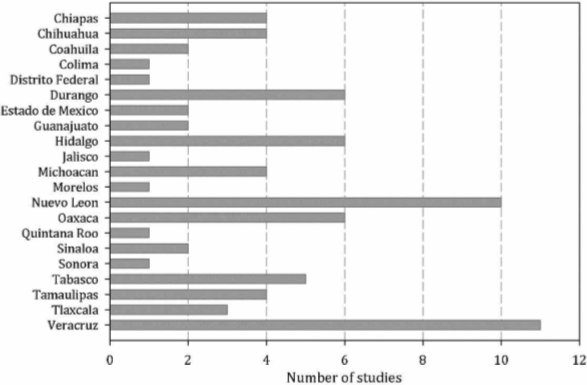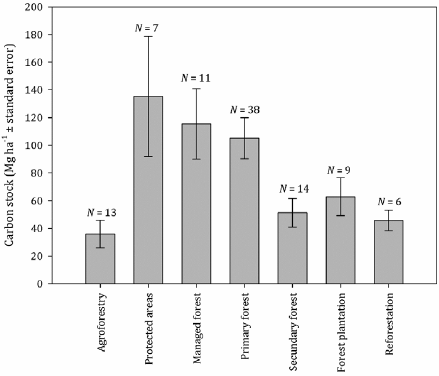Introduction
People worldwide recognize that forest ecosystems serves as a major carbon sink and as the major biological scrubber of atmospheric greenhouse gases and particularly; thus, this ecosystem is capable of sequestering large amounts of atmospheric carbon dioxide (Cunha-e-Sá, Rosa and Costa-Duarte, 2013; Dhillon and von Wuehlisch, 2013). Global CO2 emissions continue to increase (International Energy Agency [IEA], 2011). According to the International Energy Agency (IEA, 2015), global carbon-dioxide (CO2) emissions reached a record high of 32.2 gigatonnes (Gt) in 2013 (e.g. 2.17% more than in 2012).
In this regard, many efforts are being made to improve the estimation of forest carbon (C) stocks worldwide as a prerequisite to accurately assessing the contribution of forest ecosystems to the net global carbon budget (Zhang, Wang, Wang and Quan, 2009; Babst et al., 2014; Poulter et al., 2014). Prominent studies have demonstrated that assuming generic simplification (such as tree biomass consisting of 50% carbon) may produce misleading estimates (Ravindranath and Ostwald, 2008; Martin and Thomas, 2011; Castaño-Santamaría and Bravo, 2012). As a result, Thomas and Martin (2012) conducted a comprehensive synthesis of existing literature and presented a global synthesis of carbon content in tissues of live trees. Their findings have reduced the uncertainty of carbon calculation and may reduce biases such estimates of forest carbon stock and fluxes in forest systems.
The Mexican forests have been documented as diverse in terms of species (Sarukhán et al., 2009) and have great potential as a carbon sink (Torres-Rojo and Guevara-Sanginés, 2002; Comisión Nacional Forestal , 2012), and therefore they represent an opportunity to contribute to refining assessments of carbon variability across Mexico’s ecosystems. Many studies for Mexico use a constant value for carbon concentration (often 50%) to model carbon flux in different ecosystems, providing a limited understanding of the role of forests as carbon sink zones (Lamlom and Savidge, 2003).
Consequently, it is important to review and highlight the contribution of Mexican literature on this issue. The systematization of this collection in a database would provide an overview to identify the background, knowledge gaps and trends that research has taken, depending on the tree species, geographical region and ecosystem, among other data.
Objectives
In this study, we aimed to comprehensively review the existing literature related to forest tree species in Mexico to (1) evaluate variation in wood carbon concentration across taxonomic groups and climatic regions in Mexico; (2) document the general scope of carbon storage of aboveground biomass for each type land use, and (3) make this comprehensive review easily available using internet technology.
Materials and methods
A systematic review of the literature was conducted using major databases such as the Web of Science, Science Direct, Google Scholar, Sistema Regional de Información en Línea para Revistas Científicas de América Latina, el Caribe, España y Portugal and Scientific Electronic Library Online. Different combinations from a predefined list of keywords were used, such as “carbon,” “tree,” “carbon content,” “concentration,” “aboveground carbon,” “terrestrial ecosystems,” “forest species” and “Mexico.” Papers in indexed and peer-reviewed journals that were published until December 2016 were included. All gray literature (theses, technical reports, conference abstracts, seminars and scientific meetings) was excluded from the search.
In order to ensure the reliability and comparability of the review data, it was confirmed that the papers included the following criteria: 1) the description of the site and ecosystem where the study was conducted; 2) the land use type was specified; 3) where appropriate, the botanical name of families or studied species were provided; 4) tree or shrub species were included, and 5) estimates of carbon storage in the study site were explicitly described in megagrams per hectare in a given case, to document the concentration of carbon (%) in the biomass of the species studied. We use the term “concentration” explicitly when referring to elemental concentrations in wood or leaf tissue (Whitehead, 2000).
A database was created with 71 records of studies related to the evaluation of carbon storage and concentration in tree species of different ecosystems in Mexico. Papers published in 28 journals were found that were produced by 14 national publishers and where 73.2% of the studies were published. Published papers correspond to the last 20 years. Most papers (39) have recently been published during the last five years (Table 1).
Table. 1 Scientific journals that published articles related to the evaluation of storage capacity and carbon concentration in tree species of forest ecosystems.
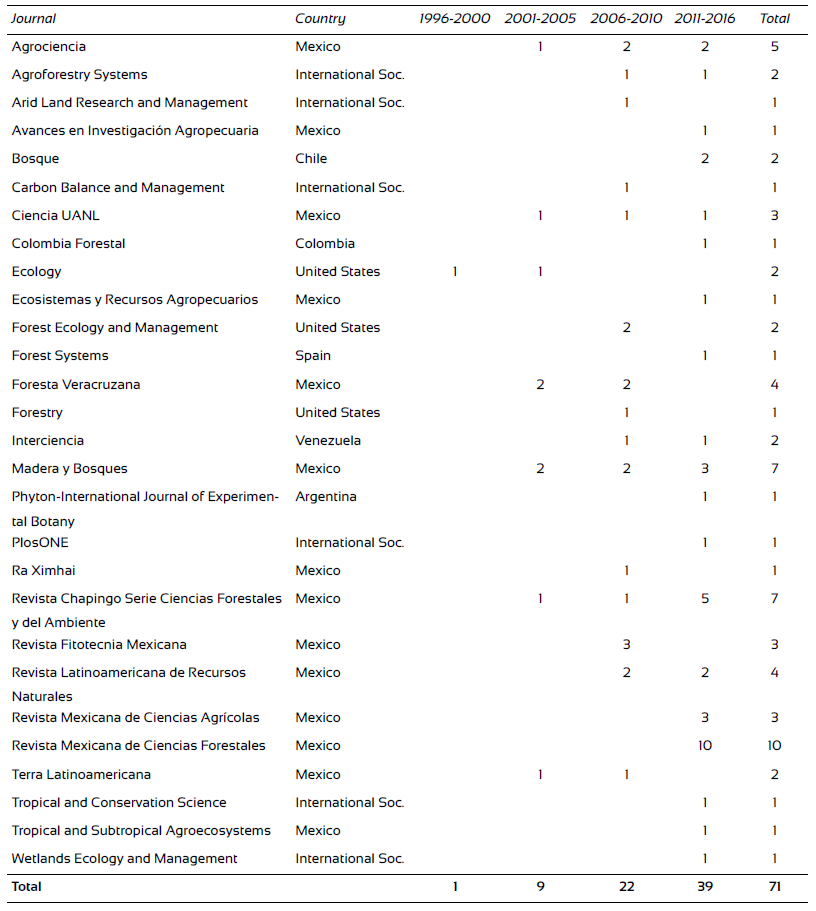
Data from each document was recorded in a database using Microsoft Access 2010 and Microsoft Excel, and was compiled so it could be accessed on a website. The complete database is available as supplementary material (Tabular_data_provided_as_supplementary_material.xls). Each record was classified by species, genus, family, ecosystem, land use system and Mexican state where the study had been conducted; also, a full reference citation including the journal information was recorded for each study.
For statistical analysis, each record was reclassified by assigning the field for taxonomic group with one of two values (conifer, broadleaf species) and another field related to the climatic region with one of two values (temperate, tropical/subtropical). Moreover, each record was assigned the value of the concentration of carbon per species mentioned by the author.
Results
Ecosystems studied
From the papers found, 25 (30%) are related to studies in coniferous tree ecosystems, the most frequently studied ecosystem. The second most frequently studied ecosystem is pine-oak forest with 18 papers. The least explored ecosystems were Quercus forests and evergreen rain forest (Fig. 1). Families most frequently mentioned in the studies are Pinaceae, Fagaceae and Fabaceae. Moreover, Pinus (Pinaceae), Acacia (Fabaceae) and Quercus (Fagaceae) were the most frequently genera mentioned in the studies.
Geographically, the largest number of studies has been conducted in the states of Veracruz (11) and Nuevo Leon (10) (Fig. 2). In Veracruz, the 11 studies are mainly conducted on plant communities of dry forests and cloud forest; meanwhile, in Nuevo Leon 10 studies have been particularly conducted on the Tamaulipan thornscrub, as well as on pine-oak forests.
Concentration of carbon in aerial biomass
From the papers analyzed here, 60 contain information related to the concentration of carbon (%) in biomass at the species level or for other taxonomic groups. A fraction of predefined carbon value or taken from another bibliographic reference was used in 34 documents. In contrast, only 26 papers specify the concentration of carbon in the biomass of the species, estimated by chemical analysis in the laboratory. Broadleaved species were most frequently analyzed and are mainly represented in tropical/subtropical climates, while coniferous species were represented in temperate climates (Table 2).
Table 2 Concentration of carbon (%) in biomass of tree species grouped by taxa and climatic region. Mean ± confidence interval (95%).

*Fraction of carbon in aboveground forest biomass defined by the Intergovernmental Panel on Climate Change (Intergovermental Panel on Climate Change [IPCC], 2006). Ref = number of references, C (%) = concentration of carbon in aerial biomass, NA = Not available.
In those laboratory studies that determined the concentration of carbon, we found an overall average of 47.7%, which coincides with the value predetermined by the Intergovernmental Panel on Climate Change (IPCC, 2006) for estimating carbon in aerial forest biomass (Table 2). In general, no differences in the concentration of carbon between species of temperate and tropical/subtropical climates (F= 0.03, p = 0.867) are shown; however, significant differences were found between taxonomic groups (F = 39.88, p < 0.0001), with the highest concentration of carbon in conifers (49.3%) when compared with broadleaved species (46.5%) (Fig. 3).
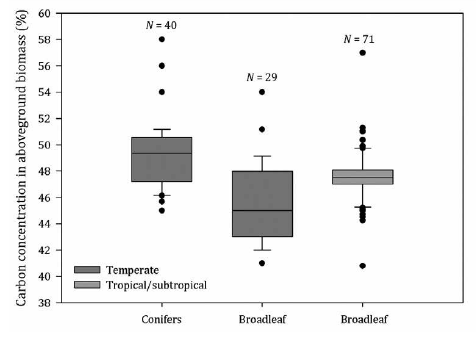
N= number of values reported at the species level (in some cases a single species was included more than once).
Figure. 3 Comparison of the concentration of carbon in forest biomass of selected species determined by laboratory analysis of samples.
A temperate forest has high concentrations of carbon in biomass, particularly in Pinus species. Silva-Arredondo and Návar-Cháidez (2009) found the highest values for Pinus engelmannii, Pinus cooperi and Pinus teocote. The genus Juniperus also has high concentrations of carbon, with values ranging from 49 to 51.2%, reported by Yerena-Yamallel et al. (2012), Jiménez-Pérez, Treviño-Garza and Yerena-Yamallel (2013), Razo-Zárate et al. (2015). Moreover, from the same group of conifers, Razo-Zárate, Gordillo-Martínez, Rodríguez-Laguna, Maycotte-Morales and Acevedo-Sandoval (2013) and Razo-Zárate, Gordillo-Martínez, Rodríguez-Laguna, Maycotte-Morales and Acevedo-Sandoval (2015) reported that Abies religiosa had lower concentration of carbon (45%).
From the group of broadleaved species from temperate regions, the genus Quercus had an average carbon value of 48.5% (Silva-Arredondo and Návar-Cháidez, 2009, Aguirre-Calderón and Jiménez-Pérez, 2011, Jiménez-Pérez et al., 2013) while species of this group with lower concentrations of carbon correspond to different shrubby species as stated by Razo-Zárate et al. (2015) in Abies forest.
In regions with tropical/subtropical climates, we found studies with carbon analysis in laboratory were limited to only broadleaved species, which had concentrations between 40.8% and 57%. The highest concentration was recorded for Gliricidia sepium (Villanueva-López, Martínez-Zurimendi, Casanova-Lugo, Ramírez-Avilés and Montañez-Escalante, 2015) and the lowest concentration was documented for Inga jinicuil in temperate deciduous forest (Hernández-Vásquez et al., 2012).
The Fabaceae family was the most well-represented in this group of species, which is reported to have an average of 47.7% of carbon in biomass; the genera with relatively high carbon values were Gliricidia, Caesalpinia and Swartzia (Bautista-Hernández and Torres-Pérez, 2003; Jaramillo et al., 2003; Villanueva-López et al., 2015). In addition, the genus Acacia (Fabaceae) had a higher frequency, although lower concentration of carbon (45.9%) (Yerena-Yamallel et al., 2012) (see supplementary material).
Carbon storages in forest ecosystems
Figure 4 shows a comparison of carbon storages or reservoirs in forest ecosystems classified by plant community. The vegetation types with higher carbon stocks are coniferous forests (106 Mg ha−1) and evergreen rainforest (106.9 Mg ha−1), although the latter have a greater variation because of different land uses, reported as being up to 353 Mg ha−1 in primary natural forests (Bautista-Hernández and Torres-Pérez, 2003). Scrubland has the lowest average carbon reserves (12.5 Mg ha−1) with maximum values of up to 28.7 Mg ha−1 in subtropical scrubland (Ordóñez et al., 2008).
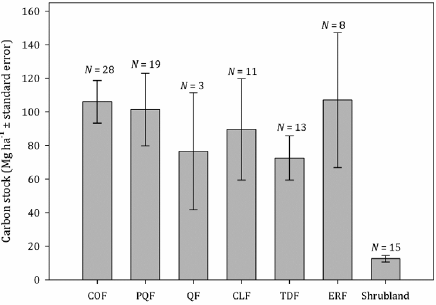
QF = Oak Forest, COF = Coniferous Forest, PQF = Pine-Oak Forest, CLF = Cloud forest, ERF = Evergreen rainforest, TDF = Tropical Dry Forest.N= number of references used to obtain the average.
Figure. 4 Storage rates of aboveground carbon per vegetation type.
However, wide variation has also been observed in carbon storage rates according to the land use type in forest ecosystems. It is noted that Natural Protected Areas have the highest carbon stocks in aerial biomass with average values of 135.3 Mg ha−1, and with values recorded by Pineda-López et al. (2013) of up to 171.9 Mg ha−1 in Abies Forests. Primary forests and forests under management are also shown to have significant reserves of aboveground carbon, whose documented stocks averaged 105.1 Mg ha−1 and 115.4 Mg ha−1, respectively. Other land uses with lower carbon storage rates are secondary forests (51.2 Mg ha−1), reforestation areas and commercial plantations (45.6 Mg ha−1 − 62.8 Mg ha−1) and agroforestry systems (35.8 Mg ha−1) (Fig. 5).
Discussion
In general, carbon storage rates have been documented most frequently for both coniferous and pine-oak forests; however, commercially valuable species have attracted the most interest and are well documented. Moreover, few studies have estimates carbon stocks in rainforests, particularly in evergreen rain forests, although the largest source of emissions of greenhouse gases in these regions is derived from the degradation and deforestation in these ecosystems (Gibbs et al., 2007).
This review shows that differences exist in the concentration of carbon between conifers and broadleaf species, coinciding with the findings of Lamlom and Savidge (2003) for North American species, and with recent revisions made by Weedon et al. (2009) and Thomas and Martin (2012) in species from different climatic regions worldwide. These differences can be attributed to some extent to a higher concentration of nonstructural carbohydrates in wood of conifers (Hoch et al., 2003; Johnson et al, 2012.), or to the difference in the composition of lignin between angiosperms and gymnosperms (Campbell and Sederoff, 1996).
In contrast, no differences in the concentration of carbon were observed between forests of different climatic regions. However, a higher concentration of carbon in tropical/subtropical climates was reported for broadleaved species. For example, Villanueva-López et al. (2015) quantified a proportion of 57% of carbon contained in the total biomass of Gliricidia sepium. Nevertheless, this carbon concentration is much higher than the value reported (44%) by Alvarado, Rodríguez and Cerrato (2007) for the same species in Costa Rica. In this sense, Ordóñez et al. (2015) mentioned that the properties of wood are variable and that attributes can change according to the local conditions such as geographical area and climate, even in tropical species. Elias and Potvin (2003) remark that trunk carbon concentration across species varies with environmental and/or growth factors.
Regarding carbon stocks for different ecosystems, coniferous and dry forests have the highest values per unit area; although tropical forests have greater variation that is attributable to the limited number of studies in these areas. In contrast, shrubland had lowest carbon stocks. This coincides with a recent analysis on carbon storage and fluxes in Mexico, where the results show that rainforests had higher stocks and productivity values, while shrubland had lower values (Murray-Tortarolo et al., 2016). Furthermore, Baral, Malla and Ranabhat (2009) report that there is considerable variation in aboveground carbon storage rates depending on the type of vegetation and its geographical location; however, accumulation rates strongly depend on the successional stage, growth conditions or dynamic disturbance in forests.
Moreover, protected natural areas had the highest values of aboveground carbon. In this regard, Sharma et al. (2013) mentioned that the conservation of natural ecosystems for the purpose of maintaining ecological integrity contributes to the mitigation of climate change; however, these areas are also at high risk of carbon loss because of the effects of forest fires or pests that cause mass woodland death.
Another option for using land with high carbon stocks is to use it as sustainably managed forestland. Under this scheme, site productivity and changes in use are the main factors related to the capture and storage of aboveground carbon (Gonzalez-Benecke et al., 2015). Similarly, when comparing primary natural forests with high average carbon storage values with secondary forests, the secondary forests in tropical ecosystems have been shown to have only 40% as much carbon stored when compared with primary forests (Stas, 2014).
Although several studies have mentioned agroforestry as a land use with a high potential for carbon sequestration, in this review we found this forest type to have the lowest average of carbon stock; during this review, we found that Nair, Kumar, and Nair (2009) noted that the methodologies for estimating carbon in agroforestry systems are generally not rigorous, leading to inaccurate calculations. However, plantations, reforestation and agroforestry systems are options that must continue to be used in efforts to reduce rates of deforestation and may contribute significantly to climate change mitigation (Masera, Cerón and Ordoñez, 2001).
Conclusions
In Mexico, most studies that have estimated carbon in biomass have been based on generic concentrations of carbon (50%) without differentiating between the carbon storage rates of various species. However, taxonomic groups should at least be considered when attempting to define the most appropriate carbon fraction used to estimate carbon stocks in forest ecosystems. In this review, we identified the need for more extensive studies of carbon at an ecosystem level, particularly in rainforests, where only a small number of studies have been conducted, which results in greater ambiguity in the reported carbon stocking rates. With this synthesis, we contribute to our understanding of the role of different forest ecosystems as carbon reservoirs and can recommend management options that contribute more aggressively to greater carbon capture and storage.











 nueva página del texto (beta)
nueva página del texto (beta)


